Archive for June 2008
Pontocho Maiko : Spring 2008
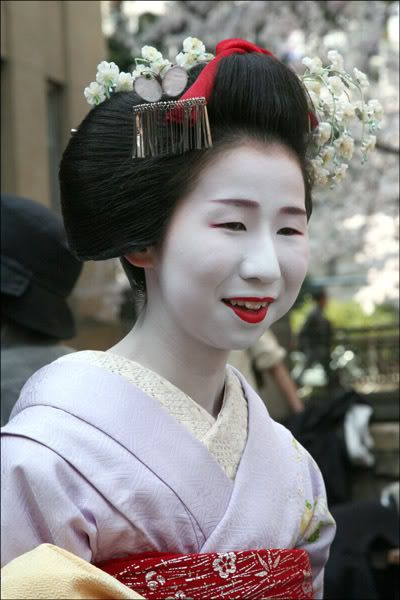
Ichiemi, now a high ranking maiko in the Pontocho district, greets the mistress of a teahouse during a small cherry blossom festival along the Takase Canal.
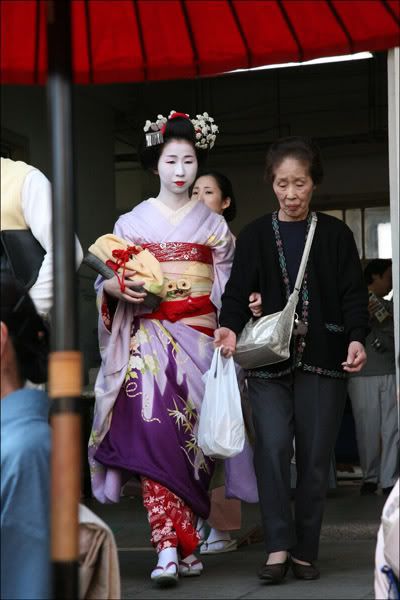
Ichiemi looks every bit the stylish, sophisticated young woman in this stunning lavender kimono ensemble. Even her adorably child-like cheeks have thinned out.

Ichiharu
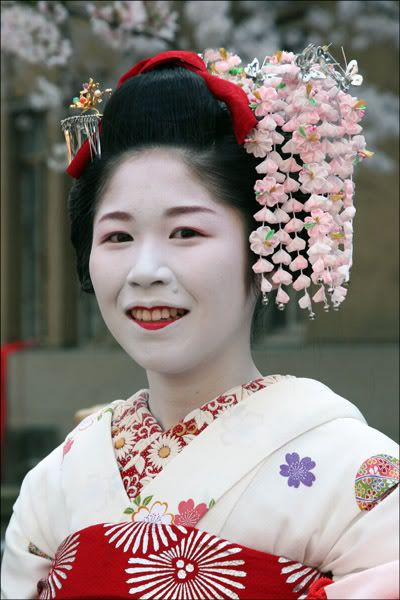
The long, fluttering strands cherry blossoms hanging from Shinaju's hanakanzashi, or flowered hair ornament, testify to her low rank and inexperience as a maiko, appealing instead to her youth and child-like charm. Compare it with Ichiharu's above, who is of a slightly higher rank.

Hisano, now a geiko, and Ichiemi walk beneath the lacey veil of cherry blossoms along the Takase canal as sunlight falls in playful patterns along the pavement.
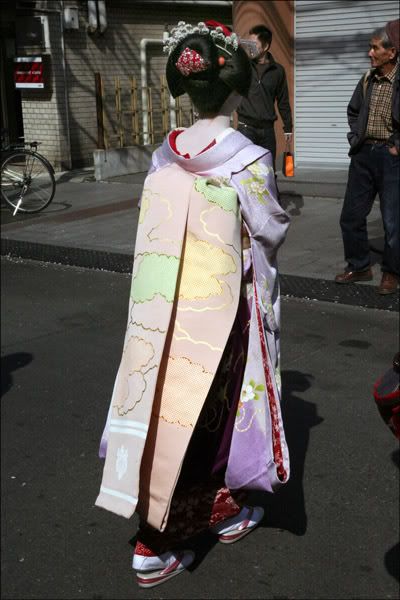
As if Ichiemi's lavendar kimono wasn't enough. Coupled with this remarkable pastel obi, colored with the sweet, pastel pallet of spring, this ensemble quickly became my favorite this season.
The 59th Kyo Odori 2008
 The maiko Satonami performs in the opening scene with the geiko Chiyoe and Kanachisa.
The maiko Satonami performs in the opening scene with the geiko Chiyoe and Kanachisa.With the passing of a winter that was more severe than most, the now-greening mountains and perfumed winds seem particularly glorious. In this refreshing season graced by gentle spring sunlight, we are once again proud to present our annual Kyo Odori.
We would like to express our gratitude to all of you who found time in your busy schedules to attend today's performance, which begins with a song-accompanied dance performed by our charming geiko and maiko in a traditional Miyagawa-cho zashiki room. Then performance then goes on to portray in a poetic manner each of the four seasons in Kyoto, with the beauty of the scenes to be found on mountains and in plains depicted through evocative dance.
Much assiduous practice and rehersal has gone into this year's event. After having viewed the fruits of our labor, any comments that you might have on our performance would be greatly appreciated...
I hereby express, on behalf of everyone at the Miyagawa-cho Kabukai, the sincere hope that you enjoy the wonderful spectacle that is the 59th Kyo Odori.
(Excerpt from the Kyo Odori Program)
 From left to right, maiko Kimiha, Satonami, and Miyoharu.
From left to right, maiko Kimiha, Satonami, and Miyoharu.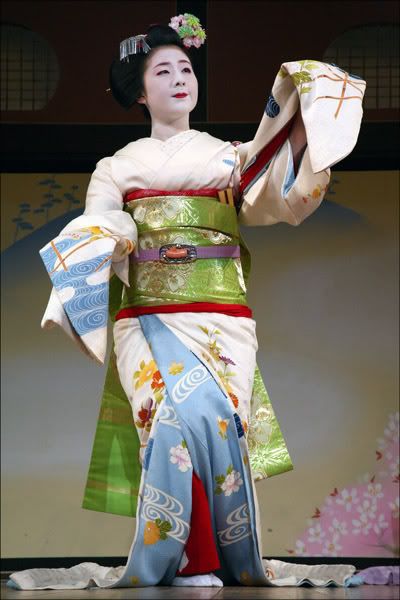
The maiko Satonami.
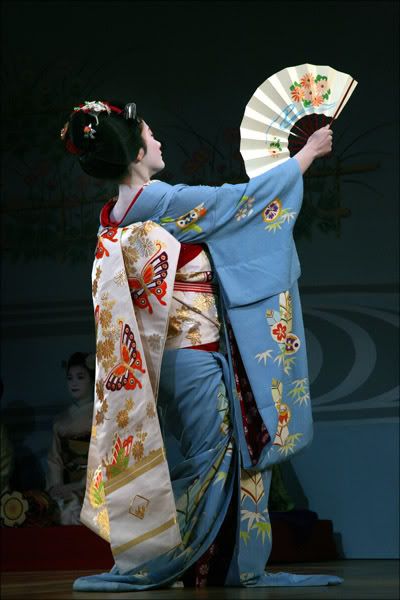
The maiko Tanewaka performs "A Brilliant Brocade of Chrysanthemums".
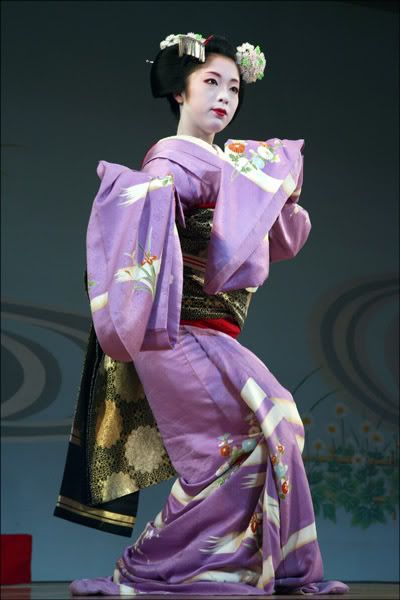
Kimiharu, little sister to one of Kyoto's most popular and beautiful maiko, Kimika.
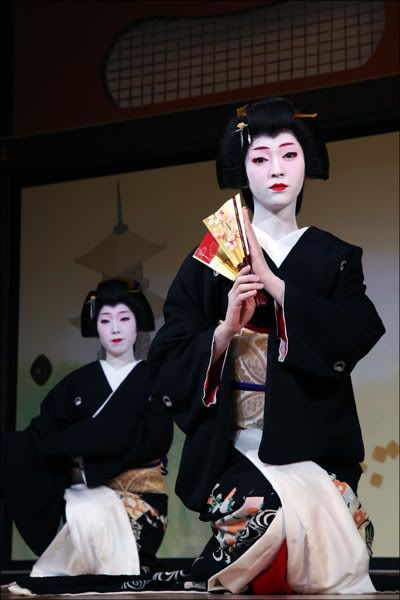
Kikutsuru performs in Kyo Odori for the first time as a geiko after turning her collar in June of 2007.

In a scene from the Tale of Genji, the geiko Fumimari dances in Heian period robes as Ukifune.
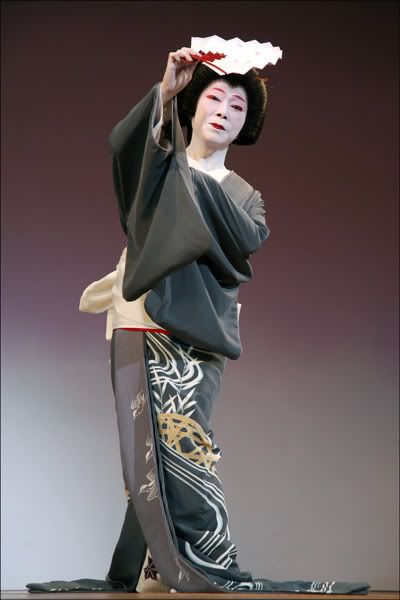
The celebrated dancer Fumicho performs her solo, a constant in the Kyo Odori program.
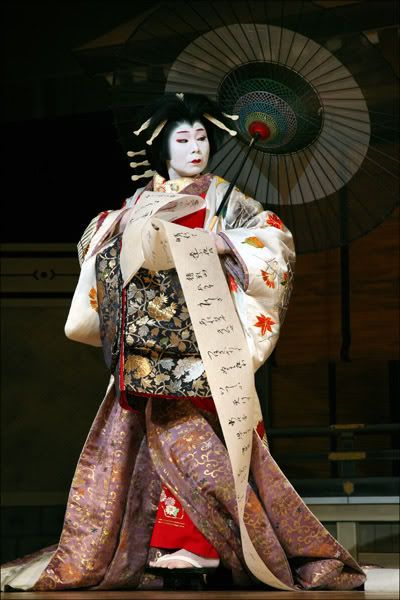
The geiko Chizuru as an Edo period courtesean in "The Tale of Princess Takiyasha".
 Maiko take center stage in a brilliant display of color, beauty, and grace during the Miyagawa-cho Ondo Song and Dance.
Maiko take center stage in a brilliant display of color, beauty, and grace during the Miyagawa-cho Ondo Song and Dance.Finding the Philosopher's Path

A view of the great gate of Nanzen-ji through a lacey veil of cherry blossoms. Nanzen-ji, or the Southern Mountain Temple, is thought to be the most famous and important Zen temple in the world.
 Located just outside of Heian Shrine, Okazaki Canal connects the Lake Biwa Canal network with the Kamo River.
Located just outside of Heian Shrine, Okazaki Canal connects the Lake Biwa Canal network with the Kamo River. A ride on a the canal is a great way to view the cherry blossoms.
A ride on a the canal is a great way to view the cherry blossoms. Walking the streets of Kyoto, somewhere in between the grounds of Nanzen-ji and the Philosopher's Path.
Walking the streets of Kyoto, somewhere in between the grounds of Nanzen-ji and the Philosopher's Path. This stoney, sakura-lined path leads to the gate of a private residence we stumbled upon as we wandered towards the Philosopher's Path.
This stoney, sakura-lined path leads to the gate of a private residence we stumbled upon as we wandered towards the Philosopher's Path. The entire estate was well hidden, surrounded by a wall offering only a glimpse of gardeners grooming the highest branches of the pine trees, shaded by magnificent clouds of cherry blossoms.
The entire estate was well hidden, surrounded by a wall offering only a glimpse of gardeners grooming the highest branches of the pine trees, shaded by magnificent clouds of cherry blossoms. Peaking over the low hedges encircling the entrance.
Peaking over the low hedges encircling the entrance. Bamboo blinds and cherry blossoms provide shade and shelter.
Bamboo blinds and cherry blossoms provide shade and shelter.
 The philosopher himself!
The philosopher himself! Absolutely one of the best places for hanami I've experienced so far. Highly recommended!
Absolutely one of the best places for hanami I've experienced so far. Highly recommended! A young girl in kimono smiles beneath the canopy of blossoms covering the path.
A young girl in kimono smiles beneath the canopy of blossoms covering the path. A couple admires the blossoms.
A couple admires the blossoms.
Evening Tayuu Procession
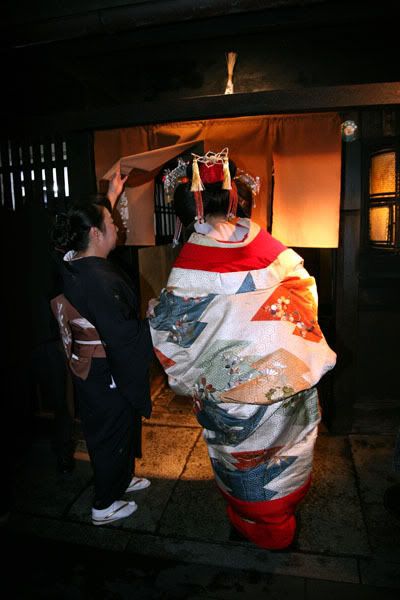
Kisaragi Tayuu ducks into a ryotei, a traditional dining establishment, along Kiyamachi-dori.
The perfect way to end an incredibly Kyoto-culture packed day of exploring Kiyomizu-dera and hanging out with maiko was with an extremely rare evening procession of Tayuu beneath the cherry blossoms.
As Peter MacIntosh explains on the Kyoto Sights & Nights website:
"Since medieval times Japan has always had some form of pleasure quarter offering various forms of entertainment, including, of course, the erotic. However, it was during the Edo period’s sakoku (1639-1854) when Japan cut off all ties with the outside world, that Japanese culture, as it is known today, flourished.
It was in these walled-in pleasure quarters such as Kyoto’s Shimabara, Tokyo’s Yoshiwara, and Osaka’s Shinmachi that the chonin (merchants) spent much of their time and money cultivating the arts."
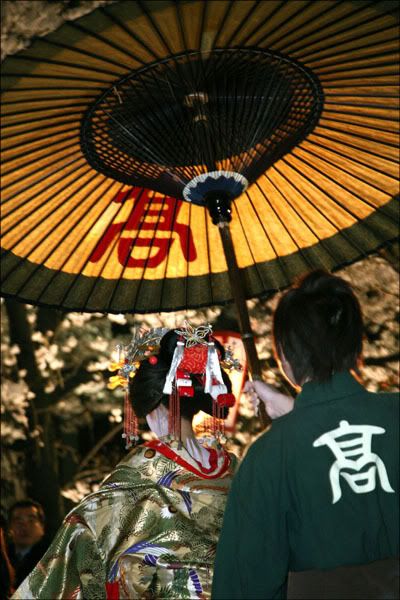
Spurned as the lowest class of citizen in the feudal Japanese heirarchy, merchants were seen as blood-thirsty parasites leeching off the hard work of others. Their wealth could not buy them respect or equaliy, except within the walls of the pleasure quarters, where, for the right price, they would be treated and entertained like kings.
"The courtesans of the pleasure quarters were trained in various arts: music, dance and poetry as well as other forms of entertainment that up until that time had been known only to the nobility. As times changed so did the tastes of the customers. The formality and expense involved meant that only the elite were able to patronize the Tayu (the top level courtesans). "

An apprentice Tayuu bundled beneath a bright red blanket as she arrives by riksha.
Liza Dalby describes the "Great Court Ladies", as Tayuu were known, in legendary proportions:
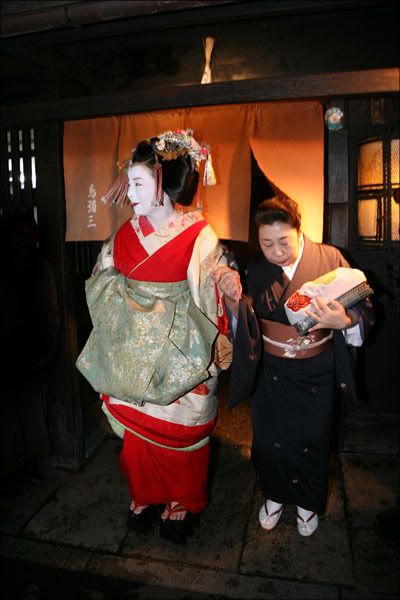
Kisaragi's obi is tied in front in the style of a full-fledged Tayuu.
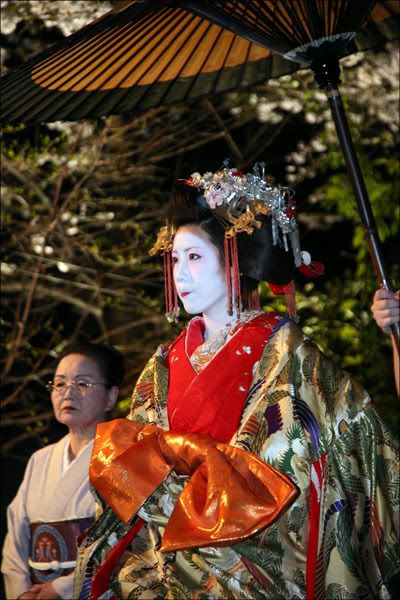
As an apprentice, her obi is tied in a bow.
As times changed, so did the tastes of their patrons. The flashy appearance and antiquated customs of the Tayuu began to loose their allure, and when the first female geisha appeared on the scene in the 1700's, it marked the begining of the end. The last recorded Oiran (as Tayuu were known in Edo) served in 1761. Only in Kyoto do a few women continue to practice and preserve the cultural arts of the Tayuu.
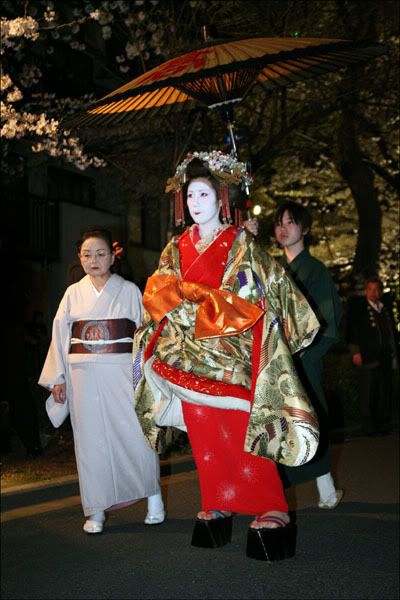
The full regalia of a Tayuu weighs about 30 Kilos.In addition, they also wear tall, black lacquered koma-geta (wooden clogs) with three legs. Even in winter, Tayuu refrain from wearing the white, fitted tabi socks that geiko and maiko wear. This tiny hint of bare flesh peaking out from beneath the many layers of her luxorious silk kimono must have been very appealing to a Tayuu's Edo period patrons.

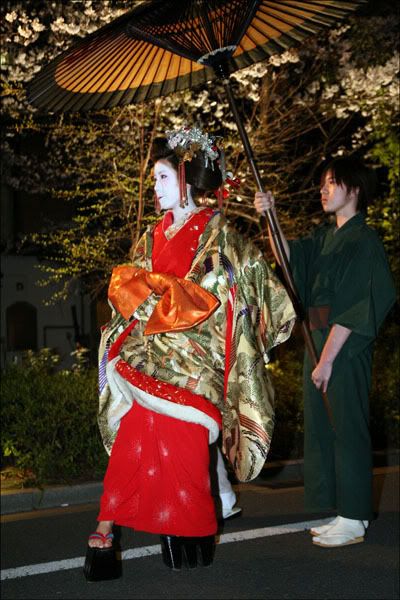
As if balancing beneath the burden of their elaborate costume on 12-15 inch platforms is not enough, Tayuu walk in what is often called a "figure eight" fashion, sliding one foot out slowly in an arch away from the other before drawing it back to center. Pausing with her bare foot exposed from beneath her crimson kimono, almost perpendicular to the other, she then points her foot forward and begins again. It takes a great amount of skill, balance, and practice to perfect, and they often hold the hands of their chaperone to help.







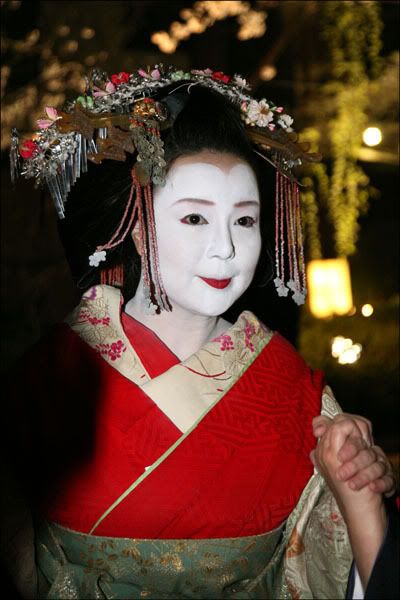


Reese Witherspoon's Tokyo Tea
Actress Reese Witherspoon enjoys taking part in a traditional Japanese tea ceremony, an activity thought to capture the spirit of healing the mind, body and soul.
Hollywood leading lady Reese Witherspoon was recently in Japan promoting breast cancer awareness as an Avon Global Ambassador. While in Tokyo she had the opportunity to participate in an intimate tea ceremony with breast cancer survivors, dressed in an beautiful powder blue kimono by Midori Yogi, who's family has dressed the Imperial Family for weddings since 1952.
As an after thought, isin't it slightly disappointing that even members of the Imperial Family can't dress themselves in kimono?
Why does it have to be so difficult? (>.<)